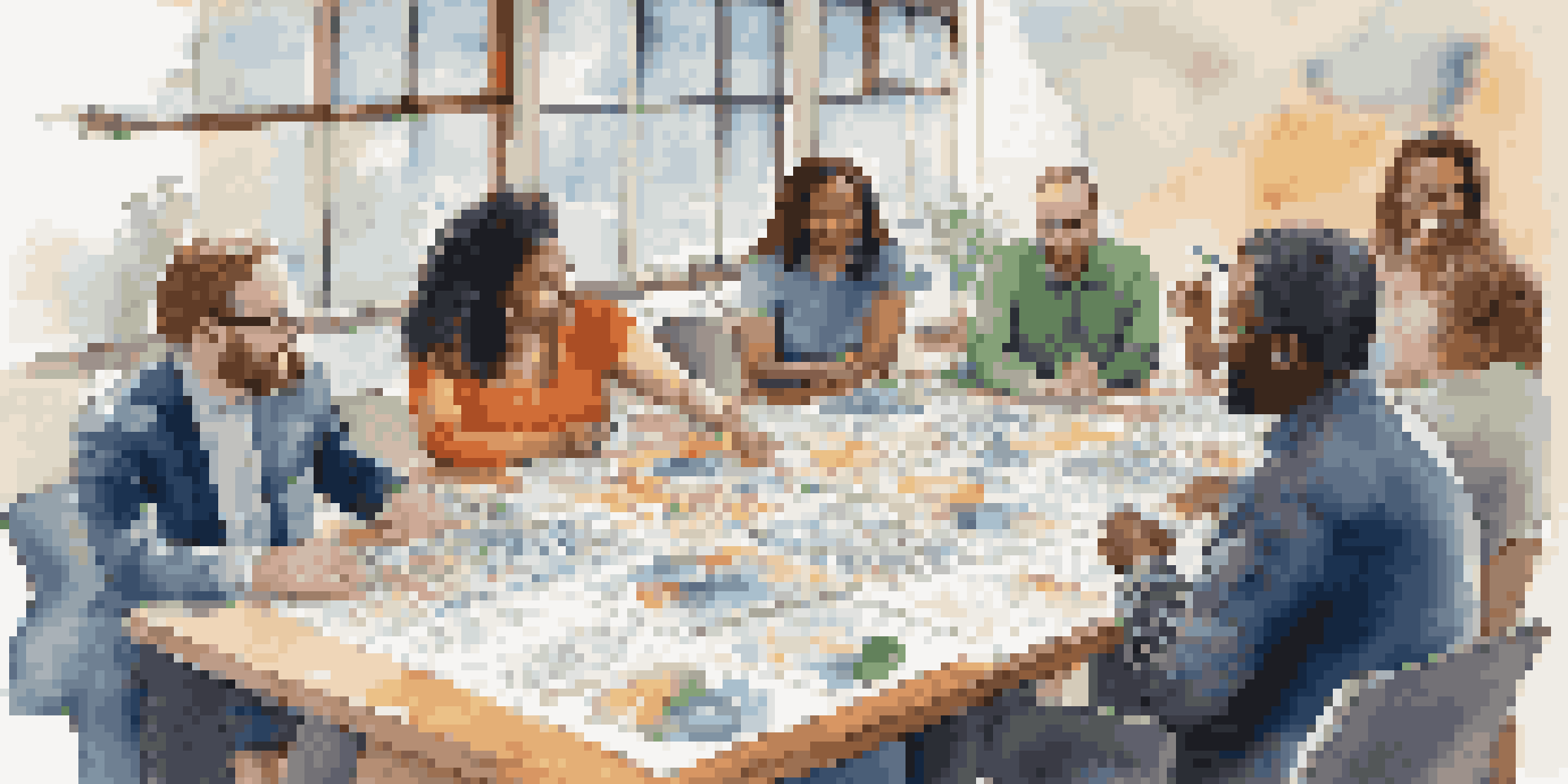The Business Model Canvas: A Tool for Nonprofits and NGOs

Understanding the Business Model Canvas for Nonprofits
The Business Model Canvas is a strategic tool that helps organizations visualize their business model on a single page. For nonprofits and NGOs, this canvas can be particularly beneficial as it allows them to clearly articulate their mission and objectives. By breaking down their operations into manageable sections, organizations can identify their strengths and areas for improvement.
Not everything that counts can be counted, and not everything that can be counted counts.
Imagine trying to navigate a complex maze without a map; the canvas serves as that map, giving nonprofits a clear direction. By utilizing this framework, organizations can align their efforts more effectively, ensuring that every team member understands their role in achieving the nonprofit’s goals. This clarity is essential in a sector where resources are often limited and every effort counts.
Furthermore, the simplicity of the canvas makes it accessible for all stakeholders, from board members to volunteers. It encourages collaboration and dialogue, fostering an inclusive environment where ideas can flourish. This engagement can lead to innovative approaches to fundraising, outreach, and program development.
Key Components of the Business Model Canvas
The canvas is divided into nine essential components, each representing a critical aspect of the organization’s operations. These components include customer segments, value propositions, channels, customer relationships, revenue streams, key resources, key activities, key partnerships, and cost structure. For nonprofits, understanding these elements can illuminate how they deliver value to their communities and sustain their operations.

For example, the 'customer segments' for a nonprofit may not be traditional customers but rather the beneficiaries of their services. Identifying these segments helps organizations tailor their programs and outreach strategies effectively. Similarly, the 'value propositions' highlight what makes the nonprofit unique and why stakeholders should support their cause.
Streamlined Strategic Planning
The Business Model Canvas allows nonprofits to visualize their strategies and adapt to changing environments effectively.
By carefully analyzing these components, nonprofits can gain insights into their operational efficiencies and potential funding sources. This holistic view enables them to craft compelling narratives that resonate with donors and volunteers alike, ultimately enhancing their mission-driven impact.
Using the Business Model Canvas for Strategic Planning
Strategic planning is essential for nonprofits to adapt and thrive in a changing environment. The Business Model Canvas can serve as a foundational tool in this process, allowing organizations to visualize their strategies and goals. By regularly updating their canvas, nonprofits can stay aligned with their mission while being responsive to emerging challenges and opportunities.
The best way to predict the future is to create it.
For instance, during a planning session, a nonprofit might identify a new customer segment that has emerged due to community needs. This realization can prompt them to adjust their programs or develop new partnerships, ensuring they remain relevant and effective. The canvas not only facilitates this identification process but also provides a framework for discussing and prioritizing initiatives.
Moreover, this tool encourages a culture of reflection and adaptability within the organization. Nonprofits can use the canvas to review their progress, celebrate successes, and pivot strategies as needed. This ongoing evaluation helps organizations remain focused on their mission while embracing innovation and change.
Engaging Stakeholders with the Business Model Canvas
Engaging stakeholders is crucial for the success of any nonprofit, and the Business Model Canvas can enhance this engagement. By involving board members, staff, volunteers, and community members in the canvas creation process, organizations foster a sense of ownership and commitment. This collaborative approach ensures that diverse perspectives are considered, enriching the overall strategy.
Imagine a community garden where everyone contributes their ideas on what to plant; similarly, the canvas allows stakeholders to share their insights on the nonprofit's direction. This input not only helps in crafting a well-rounded strategy but also strengthens relationships within the organization. When stakeholders feel heard and valued, they are more likely to support the organization's initiatives wholeheartedly.
Engagement Through Collaboration
Involving diverse stakeholders in the canvas creation fosters ownership and strengthens relationships within the organization.
Additionally, the canvas can be used as a communication tool to convey the organization’s mission and goals to potential donors and partners. By presenting a clear and compelling business model, nonprofits can better articulate their value proposition, increasing their chances of securing funding and support. This alignment of vision is essential for long-term sustainability.
Adapting the Business Model Canvas for Nonprofit Needs
While the Business Model Canvas is a versatile tool, nonprofits may need to adapt it to fit their unique context. Unlike traditional businesses, nonprofits often operate with a focus on social impact rather than profit. This distinction requires a nuanced approach when filling out the canvas, particularly in sections like revenue streams and value propositions.
For instance, instead of focusing solely on financial gains, nonprofits should consider how their programs create social value for the community. This might involve highlighting community engagement, volunteer contributions, and the long-term benefits of their services. By reframing these components, organizations can better represent their mission-driven objectives within the canvas.
Moreover, nonprofits can incorporate metrics that measure social impact into their canvas. This addition not only helps in assessing effectiveness but also demonstrates accountability to stakeholders. By aligning their canvas with their mission and values, nonprofits can create a powerful tool that drives both strategy and social change.
Overcoming Challenges in Implementing the Canvas
Implementing the Business Model Canvas can come with its own set of challenges, especially for nonprofits that may be new to strategic planning tools. Resistance to change is a common hurdle; some team members might be hesitant to adopt a new framework or may not see its value initially. To overcome this, it’s crucial to provide training and resources that illustrate the benefits of the canvas.
Additionally, nonprofits often face constraints in time and resources, making it difficult to dedicate time to the canvas creation process. To address this, organizations can start small, perhaps by focusing on one or two components at a time. This incremental approach can make the process feel more manageable and less overwhelming for the team.
Adapting for Social Impact
Nonprofits can tailor the Business Model Canvas to emphasize social value, aligning their strategies with their mission-driven objectives.
Finally, it’s important for nonprofits to view the canvas as a living document rather than a one-time exercise. Regularly revisiting and updating the canvas can help organizations stay agile and responsive to their environment. By fostering a culture of continuous improvement, nonprofits can ensure that the canvas remains a valuable asset in their strategic toolkit.
Success Stories: Nonprofits Using the Business Model Canvas
Several nonprofits have successfully utilized the Business Model Canvas to enhance their operations and achieve their missions. For example, a local food bank adopted the canvas to better understand its customer segments and refine its outreach strategies. By identifying underserved populations, the food bank was able to tailor its programs, ultimately increasing its impact in the community.
Another nonprofit focused on education used the canvas to establish new partnerships with local businesses. By mapping out their key activities and resources, they identified opportunities for collaboration that benefitted both the organization and the businesses involved. This strategic alignment not only enhanced their programs but also fostered a sense of community support.

These success stories illustrate the potential of the Business Model Canvas as a transformative tool for nonprofits. By embracing this strategic framework, organizations can navigate challenges, engage stakeholders, and ultimately make a more significant impact in their communities. The canvas demonstrates that with the right tools, nonprofits can thrive and fulfill their missions.